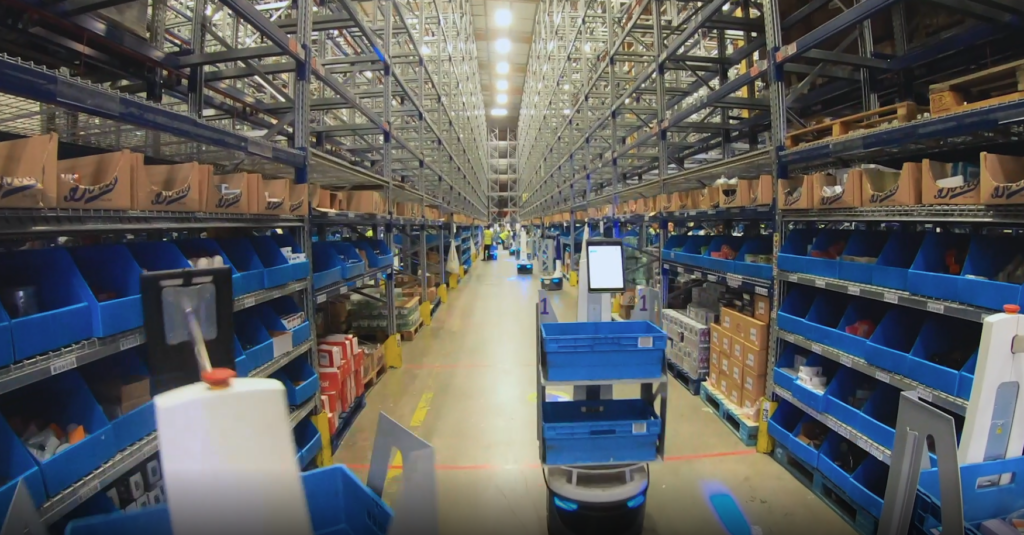Webinar Registration: The P2G Advantage
Webinar Registration: The P2G Advantage LEARN MORE
How to Manage Supply Chains as a Manufacturer with Automation and AI
Geoff Whiting, Senior Writer for Red Stag Fulfillment

Applying automation and artificial intelligence (AI) to supply chain management is an excellent way for manufacturers to increase the accuracy, speed, and efficiency of operations. Manufacturers can start by identifying which supply chain processes can be enhanced by automation, researching AI and software tools to find the best fit for their use cases, and developing a digital transformation plan that keeps them on track to keep up with the future of manufacturing.
Even companies that have already added automation to their supply chains can benefit from regular reevaluation to determine if they're using the best available tools and find additional AI use cases.
Here are the top ways that automation and intelligence are reshaping manufacturing supply chains for the better.
Supply chain automation essentials
Tools like the Internet of Things (IoT), robotic process automation (RPA), robotics, artificial intelligence, and machine learning (ML) have many applications in today's manufacturing supply chain management.
1. The Internet of Things
IoT is transforming the way manufacturing supply chains operate by allowing businesses to track the movement of parts and finished goods in real time. Some factories use IoT to track equipment performance, and alert managers to maintenance needs before a critical piece of machinery breaks down, shutting down production. In some settings, IoT devices can detect defects and notify staff of quality control issues.
2. Robotic Process Automation
RPA is software that allows manufacturers to automate repetitive and rules-based tasks. Using RPA software for data entry and transfer frees human employees to focus on higher-value tasks that improve supply chain management. RPA is an excellent tool for automating laborious processes currently executed manually.
3. Robotics
RPA is all code, but physical robots also have a critical role to play in manufacturing supply chain automation. Robots can safely handle multiple tasks, including moving boxes and pallets, simple assembly, inventory counts, maintaining equipment, and product testing. Some fulfillment warehouses even use robots to pick and pack customer orders.
4. Artificial intelligence and machine learning
AI and ML offer manufacturers powerful predictive analytics that transforms manufacturing supply chain management by improving forecasting accuracy and speed, supporting better decision-making, and reducing operational costs. AI and ML can be applied to inventory management, demand forecasting, freight route planning, and much more.
Automation and AI for manufacturing supply chains
Automation and AI have as many supply chain applications as there are supply chain permutations (which is to say, nearly infinite). But here are some common use cases for automation in manufacturing supply chains.
Intelligent inventory management
RFID, an IoT technology that uses radio frequency tags to pinpoint the location of goods, brings a level of accuracy and visibility to inventory management that isn't possible without this tech. RFID tags can be attached to products, containers, or pallets to enable real-time tracking and monitoring throughout the supply chain.
Manufacturers can affix RFID tags to containers, pallets, or individual boxes and use readers to collect data, including SKUs, batch numbers, and expiration dates of products as they move through the supply chain.
RFID is best suited to tracking goods within relatively short distances, so its best uses are within a factory, warehouse, or distribution center. Inside these confined spaces, RFID allows manufacturers to pinpoint the location of finished goods with a high degree of accuracy.
Data sharing—integrating data sources involved in a supply chain process—is another automation tool that can help with inventory management. For example, software systems that share data about inventory levels, supplier data, and purchase order history can automatically generate a purchase order when the material reaches the reorder point.
Software automation can also track purchase order status, giving manufacturers access to expected delivery dates at their fingertips and the ability to improve purchase order efficiency.
Monitor the movement of goods
Another form of IoT that can track the global transport of goods within manufacturing supply chains is GPS. Attaching a GPS device to a container or pallet of goods allows supply chain managers to follow the movement of shipments from port to rail hub to trucking route in real-time. When integrated with other supply chain systems, monitoring and reporting can be automated, easing the burden of supply chain management and increasing manufacturers' capacity to optimize shipping routes.
ML algorithms are another vital tool for analyzing shipping conditions and recommending changes to optimize supply routes and prevent interruptions. While no algorithm can predict unusual circumstances (such as a container ship getting stuck in the Suez Canal), machine learning can analyze factors such as weather patterns, shipping traffic, shipping capacity, and freight pricing to choose routes for speed and economy.
Automate repetitive tasks
Freeing personnel from repetitive tasks can increase efficiency and accuracy while improving employee morale and allowing them to spend time improving supply chain operations. Robotic process automation (RPA) is a system of software "bots" that can automate the rules-based tasks of customer order processing, inventory reordering tasks, creation of production run schedules, shipping confirmations, and shipping label generation.
Robots in warehouses, distribution centers, ports, and factories can relieve humans of dangerous or repetitive physical tasks. To apply robotics to a manufacturing supply chain, start by identifying the tasks that would benefit the most from automation—particularly processes that lead to high injury rates among workers, those that require lifting heavy loads, work done around hazmat items, and recurring motions that can cause repetitive stress injuries.
Robotics solutions can range from autonomous, mobile robots (AMRs) to robotic arms to cobots: collaborative robots that assist human workers. Integrating robotics into a warehouse or distribution workflow may require some modifications to layout or software systems, but the benefits in efficiency and safety are worth it.
Improving warehouse management
Whether it's to integrate robots or improve pick and pack efficiency, continuously refining and improving warehouse design and layout are essential to efficient fulfillment and distribution operations. AI (using data captured by IoT readers) can analyze the movement of goods and create warehousing blueprints that reduce travel distances and maximize efficiency.
AI gives manufacturers the capacity to run simulations to see how different warehouse management strategies operate before implementing them. Automation also makes it easier to capture and analyze data, so supply chain managers can quickly pivot to meet the needs of changing circumstances.
IoT and robotics integrated with warehouse AI create a dynamic environment where managers have the data and analytics they need to identify and put in place best practices in warehouse management.
Bringing big data to bear on business decisions
With the power of AI and machine learning, manufacturers can use predictive analytics to make smarter business decisions. That keeps supply chains moving without disruptions and gets goods and materials where they need to be at the correct times to meet demand.
One of the most critical uses of automation in manufacturing supply chains is demand planning. Predicting future demand is an imperfect science, but the power of AI and ML to digest and analyze big data sets brings a level of accuracy that isn't possible without automation.
In today's challenging supply chains, manufacturers need to plan for disruptions in transport and supply due to extreme weather, civil unrest and war, black swan events like a global pandemic, and more. Predictive analytics can analyze risks and suggest mitigation strategies to sidestep interruptions in supply. In addition, AI and ML tools can analyze economic and market conditions to predict future needs and provide well-founded estimates of the amount and timing to move goods through the value chain and place them before consumers at just the right time.
Conclusion
Manufacturing supply chains need to use the full range of automation and AI tools for companies to stay competitive. Businesses may never return fully to the just-in-time (JIT) supply chains of the past, but automation allows manufacturers to approach JIT agility and efficiency.
Companies should determine which tools fit their supply chain use cases and commit the resources to put them to use, including employee training, investment in new IT systems, and changes to warehouse layout. The benefits, in cost savings and speed of supply chain operations, more than justify the upfront expense of adding automation.
About the Author
Geoff Whiting is the Senior Writer for Red Stag Fulfillment, an eCommerce 3PL focused on supporting heavy, bulky, and high-value products. He has more than a decade of experience covering eCommerce, technology, and business development. In his free time, Geoff enjoys exploring new cuisines and music, and trying not to get too lost listening to podcasts while walking in nature.




